When we re-did our garden layout in the winter of 2023/2024, the goal was to turn the wide open vegetable and flower garden, where everything burned up in the summer, into a “park garden” with lots of shade trees. I researched a lot and made up a nice little shortlist of more or less drought-tolerant deciduous trees that wouldn’t grow to enormous heights (under 10 meters), would form wide shade tops and would offer lovely flowers and/or pretty foliage (fruit trees were not on the agenda for this part of the garden).
We already had two Morus bombycis kagayamae (sterile mulberry) that were doing quite well, so no need to add any more of those. I knew that loved the bright yellow of Mimosa flowers in late winter, the luminous pink of Cercis siliquastrum in early spring, the dappled shade and powder-puff flowers of Albizia julibrissin, and the wonderfully fragrant flowers of Melia azedarach. Other trees that looked promising included Fraxinus ornus, Paulownia tomentosa, Chilopsis linearis, Robinia pseudoacacia casque rouge, Koelreuteria paniculata, Schinus molle, and Catalpa bignoninoides.
Mimosa/Acacia
The idea of a mimosa tree (Acacia dealbate etc.) was eliminated because I read that it can be very, very invasive and a real thug in the garden as well as when it escapes into nature.
Paulownia tomentosa
Paulownia tomentosa “Hulsdonk” looks gorgeous and is reputed to grow very very fast and not to high. However, as a general species Paulownia is also potentially invasive and even if it doesn’t propagate itself, it will grow enormously long and thick lateral roots everywhere. Our gardener called it an unfortunate fashion trend and didn’t think it was very drought resistant either.
Catalpa bignoninoides
This tree was eliminated because it grows too high and because the gardener didn’t think it would thrive in our very hot and dry summer climate.
Schinus molle
This tree would have been nice and well-suited for the climate, but its habit is more hanging than wide, making it unsuited for what we tried to achieve in this part of the garden.
Morus kagayamae “Fruitless”
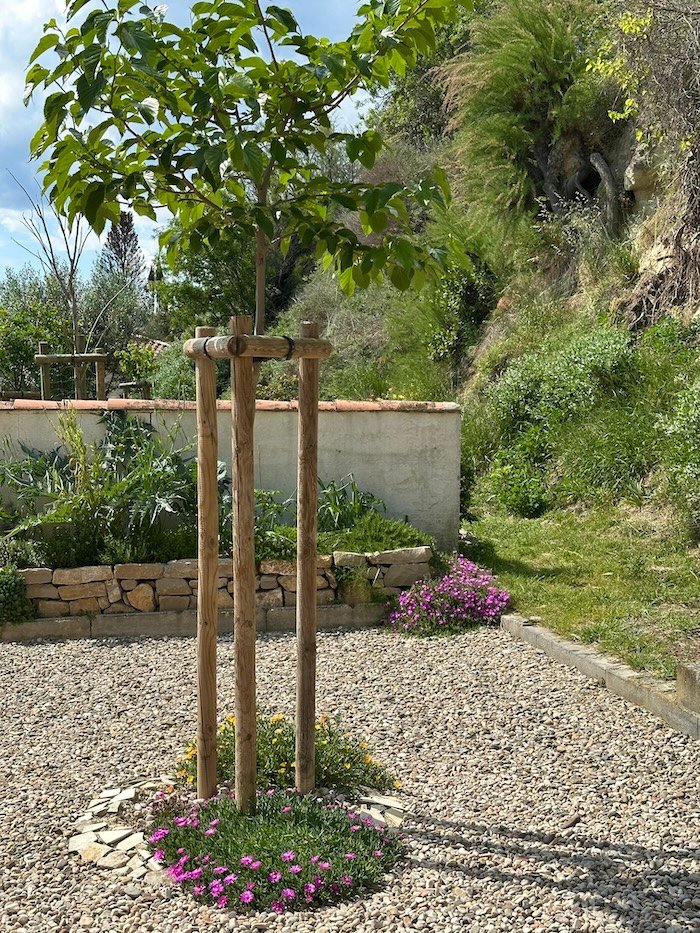
In 2023 we had already planted two fruitless Mulberries for shade and they are doing very well. These trees are very popular for shade around houses and terraces because they have dense foliage with big leaves in a wide canopy – all without any berries that would mess up the floor below. Morus kagayamae grows quite quickly and stays a manageable size of about 8 meters height and 10 meters width.
Koelreuteria paniculata
Although I couldn’t get the variety I originally wanted (“Coral Sun”), this tree made the cut. It has pretty flowers in June that turn into hollow pods and its foliage has a lovely fall color. It doesn’t grow by leaps and bounds but it does well and seems on the way to being fully established in the garden.
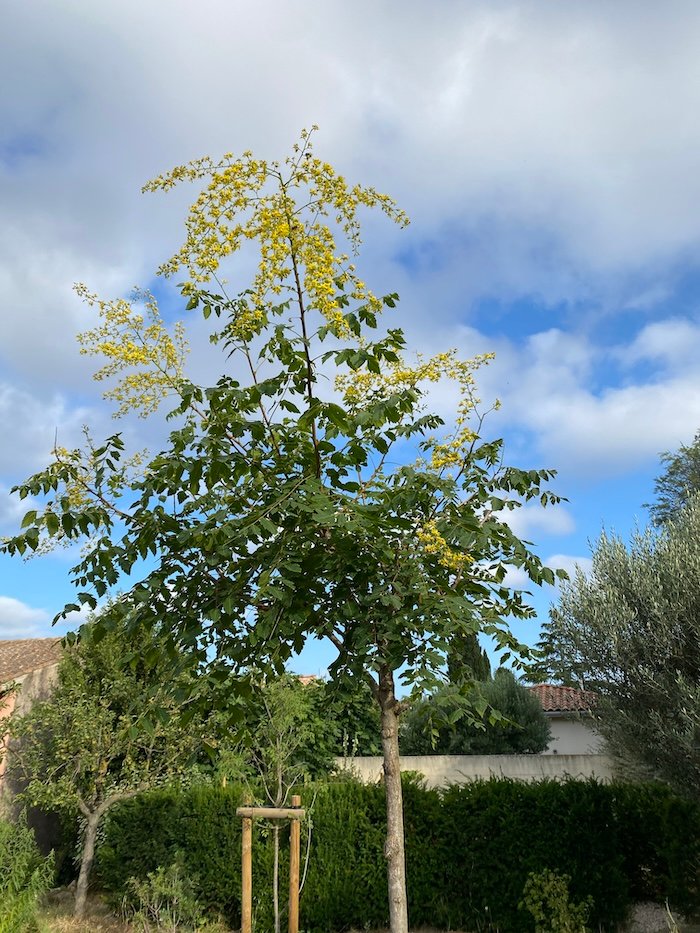
Robinia pseudoacacia casque rouge
This one was a recommendation from another gardener and it has turned out spectacularly well. It is a hybrid between regular white-blooming Robinia pseudoacacia and Robinia hispida. It grows smaller (8×4 instead of 15×4 meters) than Robinia pseudoacacia and the fragrance of the flowers is less intense. But it is also less invasive than its white-blooming parent. It does reseed itself but does not form off-shoots, and the seedlings are easy to pull up.
It has grown spectacularly fast in height and width and is now almost twice as high as the Morus kagayamae planted in the winter of 22/23 and definitely twice to three times as big as all the other trees planted at the same time. Its flowering in April-May was spectacular and it shows an occasional re-bloom during the summer months. It is a bit sensitive to wind which is why we planted it farthest from the western end of the garden. However at its current height it is being battered and we will have to take the crown down a bit in the fall.
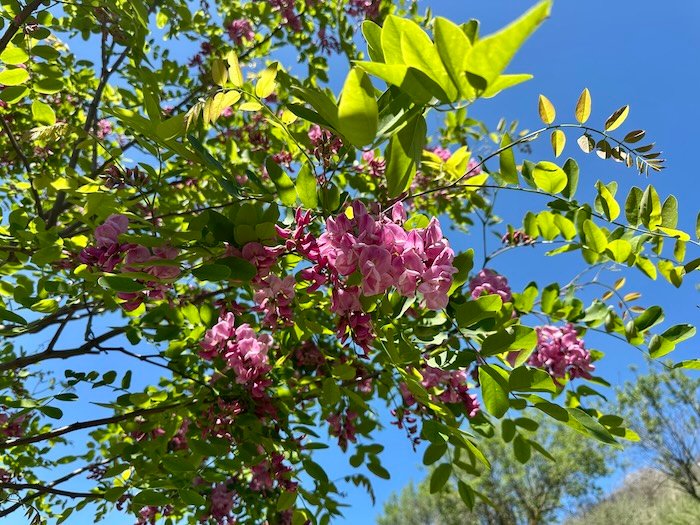
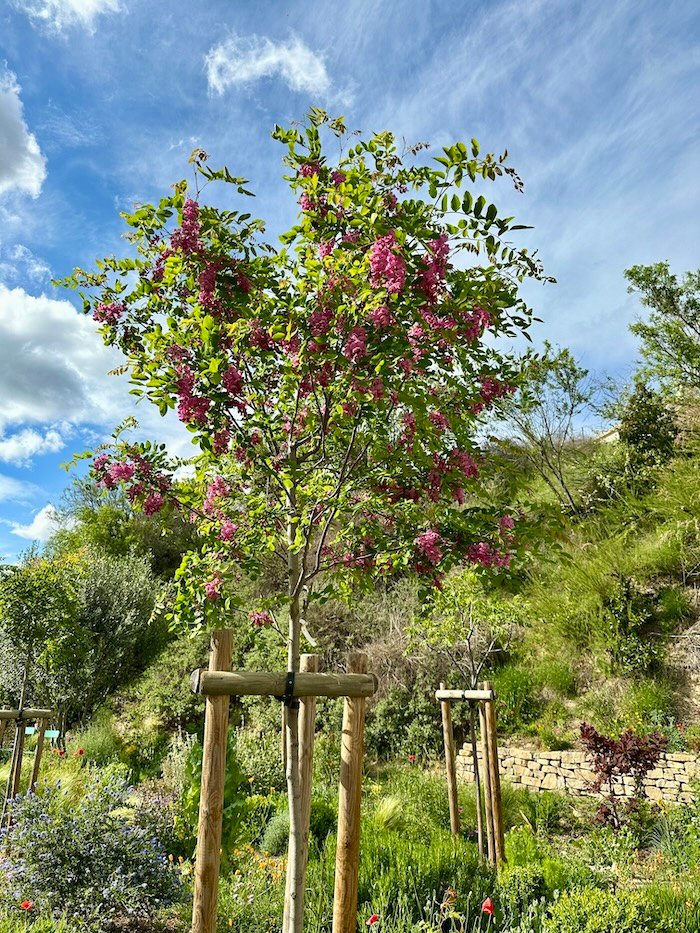

Fraxinus ornus
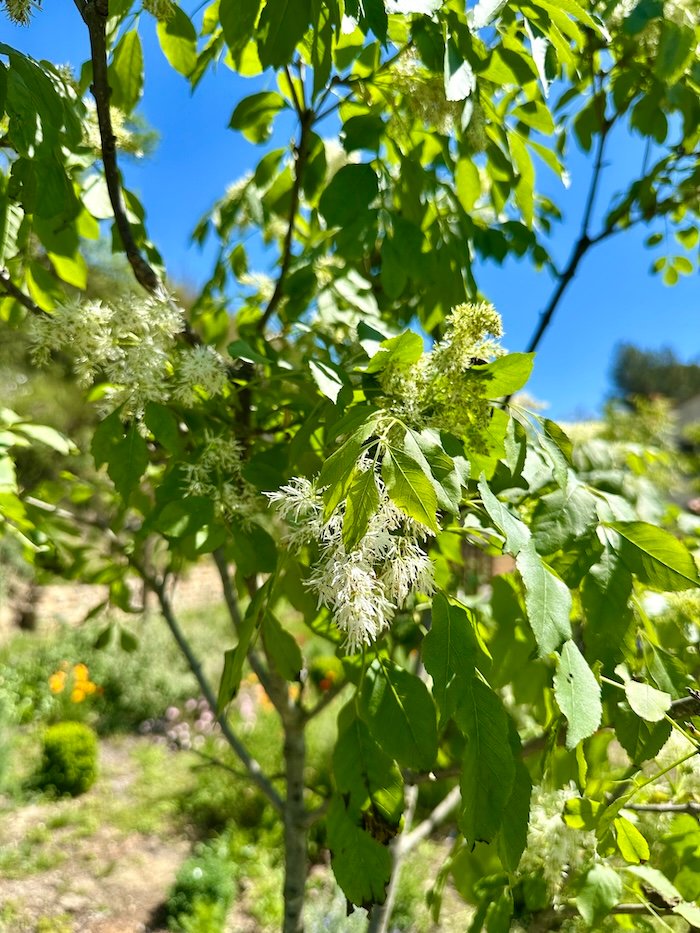
I had fallen in love with Fraxinus ornus from the pictures I saw online and could not understand why our gardener called it “boring”. I should have listened. Yes, the flowers are lovely for the week or two that they bloom in April, but afterwards it is a bit of a drab sort of tree. But what the heck – every family has that one relative who is not really cool. And it’s a healthy tree, not prone to diseases or wind breakage. And who knows, maybe it will develop into a wonderful tree after it’s fully established itself.
Melia azedarach
One of the loves of my life and simply a joy to behold. We have Melia trees all over the village and in May their purple and white flowers perfume the air around them with a lovely lilac scent. Our tree is growing and doing very well and this year had a long lovely flowering period.

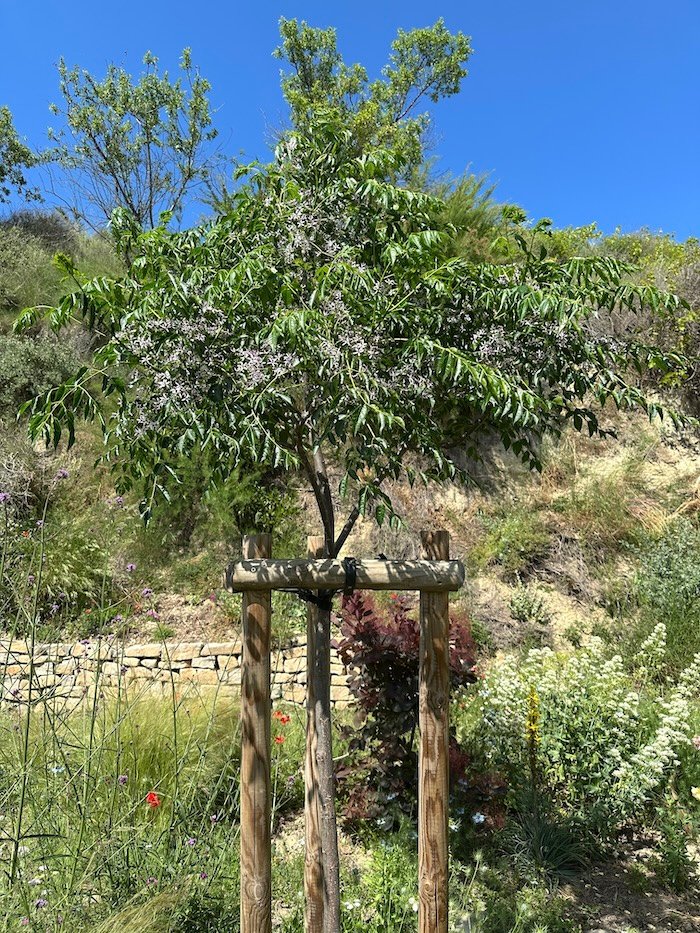
Albizia julibrissin
A love story that seemed to turn into heartbreak. Like all the other trees we planted, this Albizia was already pretty tall, even taller than the others. It took ages to show leaves in May of 2024 but afterwards it seemed to do well. The trunk thickened, the leaves looked healthy, and we even had a few flowers. Then, in the winter, it did not lose its leaves until February and by May 2025 it looked dead as a doornail. No idea what happened. We alerted our gardener that we needed a replacement and were thinking about alternatives.
Then, at the beginning of July, we discussed cutting down the Borage shading the beans I had planted around the Albizia’s support posts. Looking closely, we suddenly discovered a new albizia growing up around the dead trunk! It is growing rapidly and we’re very hopeful to have our favorite tree after all. After all, its roots are already well established and it is just a matter now of growing up.
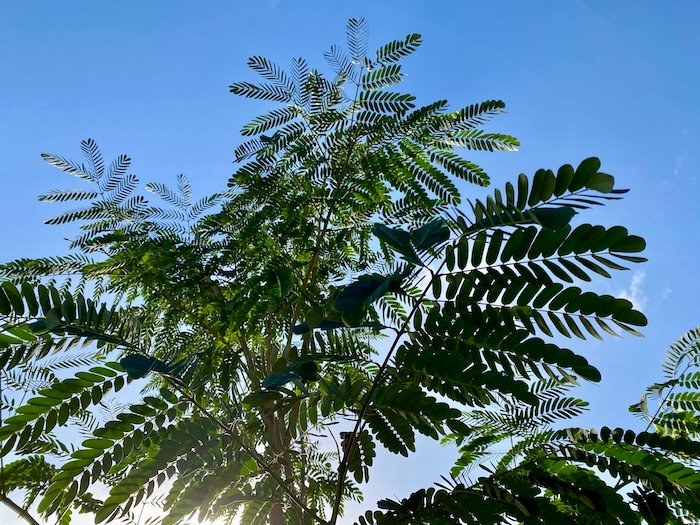
Cercis siliquastrum
Careful optimism is the motto here. Let’s just say that it hasn’t become smaller since it was planted. But is hasn’t really grown that much either – maybe it still needs to time to find its footing. We enjoy the flowers and hope for the best.
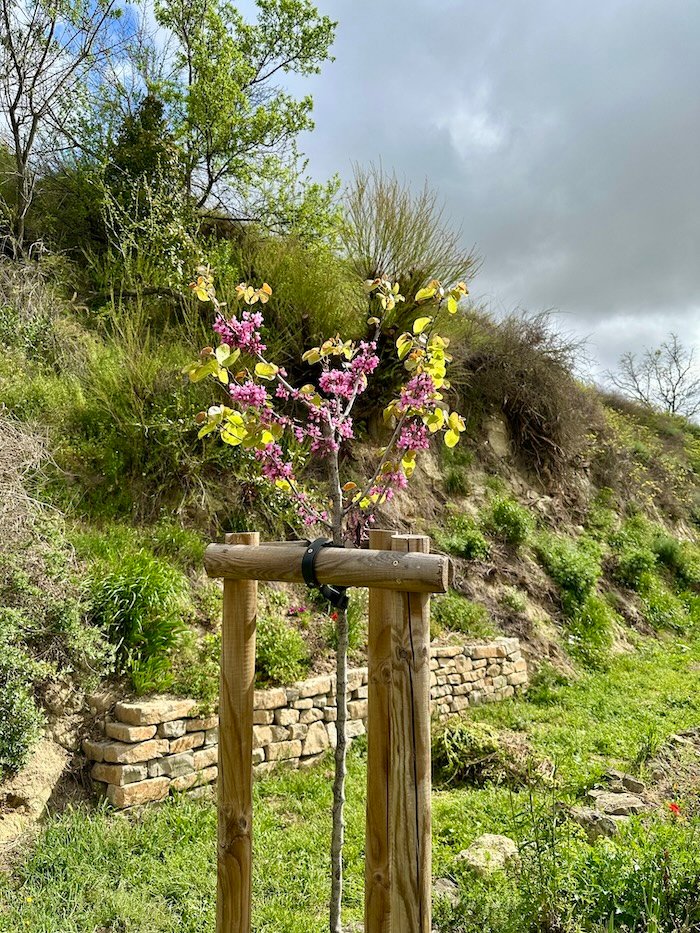
Chilopsis linearis
I could not find a reasonably sized Chilopsis linearis for a reasonable price at the time, so I planted a small specimen later in another spot of the garden where space became available. Simply because it is reputed to be absolutely drought-resistant while also being absolutely lovely to look at. It is still small and will probably take a few more years to flower. Chilopsis linearis is native to North American desert regions and thrives in dry, poor soils – it should not be fed. Important also: it takes until mid-April to show leaves in the spring.
How to plant trees in a Mediterranean Garden
Our gardener is fond of saying that trees should be planted bare-rooted and not from pots and/or that they should be small to have a better chance of establishing themselves. Well, I’m not a patient person. I want shade in two years, not in five. So we went with tall trees growing in small pots from the local nursery, at very good prices. So far, so good – only one out of six has died. For the planting we took all possible care:
- Timing: They were planted in December, giving them lots of time to find their footing before summer.
- Technique: The gardener dug big holes in the ground, filled them with fresh soil mixed with compost and guano, put in the trees and watered them well. Then he attached each to three sturdy posts to help them withstand the wind in the first 2-3 years.
- Watering: we deep-watered them every 2-3 weeks the first summer per gardener’s orders, this summer we will deep-water them every 2 months. Deep-watering means letting a small but steady drizzle from the hose soak into the ground over 1-2 hours. Or putting down “Baumbad”-bags that will also release water over several hours.
They should not be watered more often, according to the gardener, so they can get accustomed to having to look for water deep in the ground.
As the crown widens, the roots widen and it is important to not only water next to the trunk in years to come. - Pruning: besides a first slight pruning to make them less wind-resistant, not much has been done yet. This fall we will begin to shape the crowns a bit.

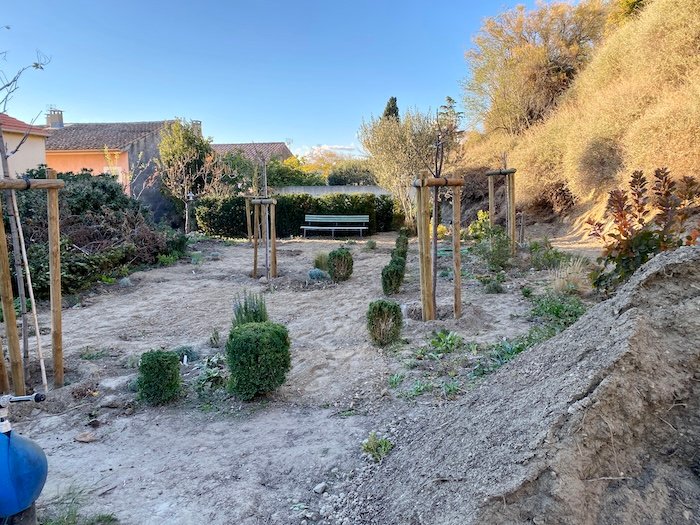
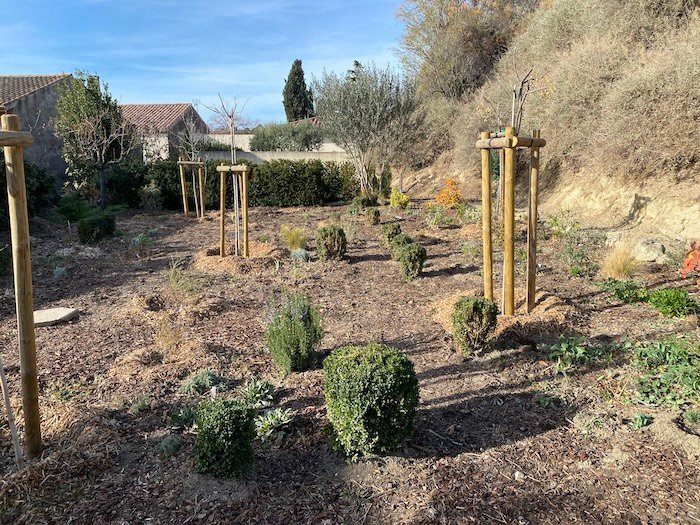
Leave a Reply